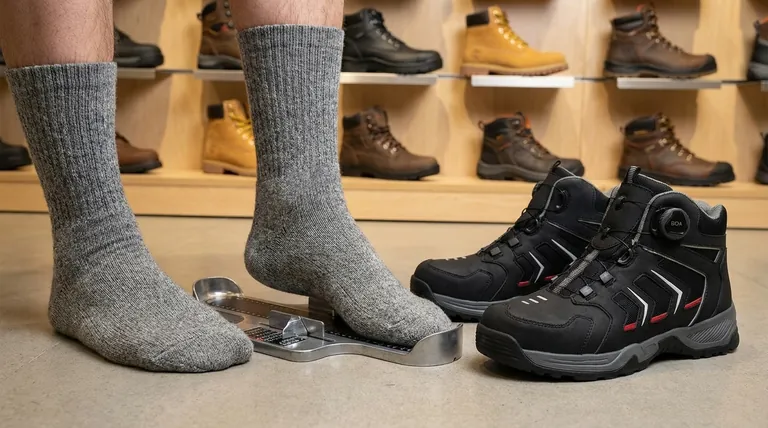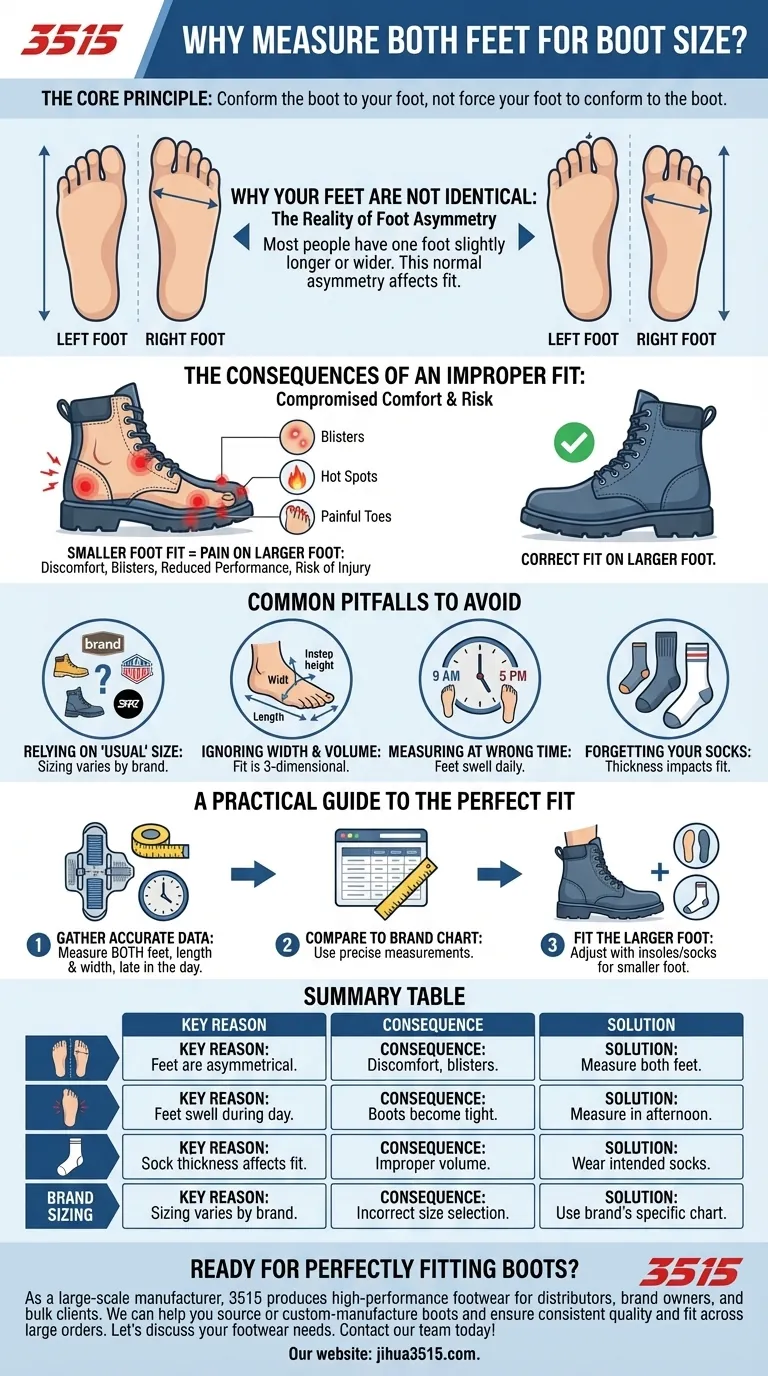It is essential to measure both feet because human feet are rarely the exact same size. Most people have one foot that is slightly longer or wider than the other, and failing to account for this difference is a primary cause of discomfort, blisters, and foot pain. The correct boot size must always accommodate your larger foot.
The core principle of proper boot fitting is to conform the boot to your foot, not force your foot to conform to the boot. Measuring both feet is the first and most critical step in honoring this principle, ensuring your fit is dictated by your larger foot for all-day comfort and support.

Why Your Feet Are Not Identical
The Reality of Foot Asymmetry
It is a simple anatomical fact that most people have slight size and shape differences between their left and right feet. This is perfectly normal and is known as asymmetry.
This size discrepancy can be in length, width, or both. While often minor, the difference is significant enough to affect the fit of structured footwear like boots.
The Impact of a Small Mismatch
Choosing a boot based on your smaller foot's measurement will inevitably cause problems for your larger foot. The boot will be too short or too narrow, leading to cramped toes, excessive pressure, and friction.
This constant pressure creates painful hot spots, blisters, and chafing. Over time, it can even contribute to more serious conditions like bunions or hammertoes.
The Consequences of an Improper Fit
Compromised Comfort and Performance
A boot that is even slightly too small on one foot creates a constant, nagging distraction. For hiking, work, or any activity, this discomfort reduces your endurance and focus.
The boot cannot flex properly with your foot's natural movement, leading to an unstable stride and increased fatigue.
Risk of Injury
Blisters are the most common result of a poor fit, but the issues can be more severe. A cramped toe box can lead to bruised toenails or nerve irritation.
An unstable fit also increases the risk of rolled ankles, as your foot may not be properly seated and supported within the boot's structure.
Common Pitfalls to Avoid
Relying on Your "Usual" Size
Boot sizing is not standardized across brands. A size 10 in one brand might fit like a 10.5 in another. Never assume your size; always rely on a current measurement.
Ignoring Width and Volume
A proper fit is three-dimensional. Besides length, you must consider the width of your foot and the overall volume (instep height). Many fitting issues occur when a boot's length is correct but its volume is wrong.
Measuring at the Wrong Time
Your feet naturally swell throughout the day due to activity and gravity. Measuring in the morning can give you an inaccurate, smaller reading.
Always measure your feet in the late afternoon or evening to get their largest possible size, ensuring your boots will remain comfortable even after a long day.
Forgetting Your Socks
The thickness of your socks significantly impacts boot fit by taking up volume inside the boot. Always wear the type of socks you intend to use with the boots when trying them on or measuring.
A Practical Guide to Finding the Perfect Fit
The goal is to gather accurate data about your unique feet to make an informed choice.
- If your primary focus is accuracy: Get measured at a reputable shoe store using a Brannock device, ensuring they measure both length and width for both feet late in the day.
- If your primary focus is online shopping: Measure your own feet at home using a ruler or tape measure while standing, and carefully compare your measurement in inches or centimeters to the specific brand's sizing chart.
- If you are between sizes or have one foot larger than the other: Always buy the size that comfortably fits your larger foot. You can easily add a thin insole or wear a slightly thicker sock to perfect the fit on your smaller foot.
Ultimately, investing a few minutes to measure both feet correctly prevents discomfort and ensures your boots are a reliable tool for your work or adventures.
Summary Table:
| Key Reason | Consequence of Ignoring | Solution |
|---|---|---|
| Feet are asymmetrical | Discomfort, blisters, pain on larger foot | Measure both feet |
| Feet swell during the day | Boots become too tight | Measure in the afternoon |
| Sock thickness affects fit | Improper volume and pressure | Wear intended socks when measuring |
| Sizing varies by brand | Incorrect size selection | Use the brand's specific size chart |
Ready for Boots That Fit Perfectly?
As a large-scale manufacturer, 3515 produces a comprehensive range of high-performance footwear for distributors, brand owners, and bulk clients. Our production capabilities encompass all types of work boots, hiking boots, and safety footwear, ensuring durability and superior comfort.
We can help you:
- Source or custom-manufacture boots that meet the precise sizing and comfort needs of your customers.
- Ensure consistent quality and fit across large orders, backed by our extensive manufacturing expertise.
Let's discuss your footwear needs. Contact our team today to get a perfect fit for your business!
Visual Guide

Related Products
- Wholesale Safety Footwear Manufacturer for Bulk & Custom OEM Orders
- Premium Wholesale Waterproof Safety Boots High Performance Protection for Industrial Markets
- Premium Grain Leather Safety Boots for Bulk Supply
- Wholesale Slip-On Safety Boots Manufacturer - Custom Puncture-Proof & Steel Toe
- Customizable Anti-Smash Safety Boots for Wholesale & Private Label Manufacturing
People Also Ask
- Is there a downside to steel toe boots? Weighing Protection Against Daily Comfort
- Is safety toe better than steel toe? A Guide to Choosing the Right Protection
- What's the difference between safety toe and steel toe? Choose the Right Protective Footwear.
- What is the OSHA standard for safety-toe boots? Ensuring Compliance and Worker Protection
- Why is manufacturer diversity and inclusion important in work boot design? For Superior Fit, Safety & Comfort



















